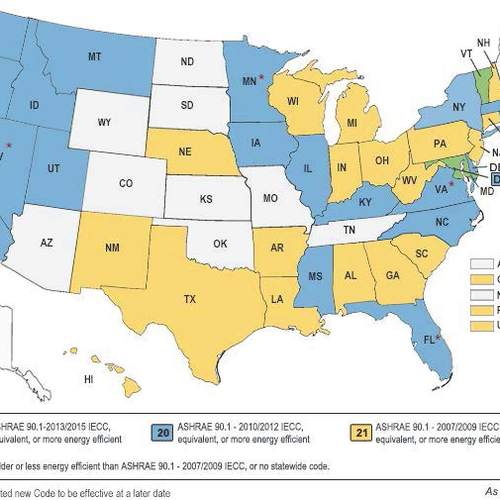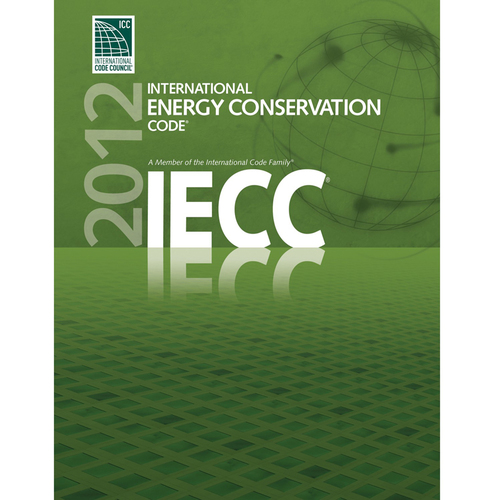
Building energy codes and ESG (environmental, social, and governance) policies are the problem and deregulation is the solution. This is what National Association of Home Builders (NAHB) Chairwoman Alicia Huey would have us believe, as evidenced by her organization’s recent statement to Congress, in which Huey laments, in part, the “costly” and “restrictive” nature of grants made through the Inflation Reduction Act (IRA) that incentivize the adoption of more progressive energy codes.
Huey’s concerns aren’t completely unfounded. Yes, introducing new regulatory measures into any market can be disruptive, especially when said market is still in the throes of a worker shortage, supply chain issues, and global inflation. And the building industry remains a long (!) way off from figuring out how to scale up the sourcing, manufacturing, and delivery of low-carbon building materials that can eventually supplant everything from standard concrete and steel to PVC and foam insulating materials with a high GWP. Thus, assuming states that aren’t California, Massachusetts, New York, and select others will maintain their status quo, updated codes that stress cleaner energy and lower emissions across the board will indeed feel burdensome, and only exacerbate the housing affordability crisis.
The NAHB’s stance on the 2021 International Energy Conservation Code (IECC), in particular, which sets minimum requirements for energy-efficient buildings, is focused on the code’s overall cost effectiveness. Citing cost impact analysis from the Kansas City Home Builders Association, the NAHB proffers that the IECC can add up to “$31,000 to the price of a new home” and take “as long as 90 years for homeowners” to see any return on investment. “Some of the measures in the 2021 IECC offer the consumer negligible energy savings and no meaningful performance improvement,” says a NAHB representative.
“The building industry already is constructing homes that are much more…
Weekly Newsletter
Get building science and energy efficiency advice, plus special offers, in your inbox.

This article is only available to GBA Prime Members
Sign up for a free trial and get instant access to this article as well as GBA’s complete library of premium articles and construction details.
Start Free TrialAlready a member? Log in















7 Comments
While I support higher levels of building performance and almost always go above code minimum levels on my projects (with modeled ROI in a reasonable range), I have heard here and elsewhere a lot of comments that the only way to even meet IECC2021 standards is with mountains of foam and the high levels of embodied carbon and elevated risk to installer and occupant health that it comes with. While I haven't found the need to use foam to get R-60 ceilings or R-25 walls, apparently for most architects and builders it's too hard.
Until low-carbon building practices reach the mainstream, I would like to see codes stay where they are; despite good intentions, this is the absolute worst time in human history to dump a lot more carbon into the atmosphere. We can more easily accommodate lower-performing new homes that have low levels of embodied carbon than we can high-performance homes full of foam.
Without pushing requirements, it doesn't seem like there are many folks interested in developing best practices to hit higher levels of insulation without foam or other expensive options in terms of dollars and carbon. I do see where you are coming from, but my view is that forcing the ordinary builders to develop techniques might mean that many of the low cost options discussed here that seem niche become mainstream.
On the affordability front - my argument is that it's a matter of prioritization. Maybe you can't build that 3,000 sqft tract home for the same price anymore. But one could build a 2,200 sqft home to a higher standard for the same price... And the family of 3-4 probably lives comfortably there. If small homes were already the norm, then the argument would be different. But in my mind, the evidence does not support the claim that the NAHB has. Maybe max heat load or tiered requirements based on home size should be considered. If affordability is the issue, then build smaller to looser requirements. But when we look at the size of the homes that are commonly built today, it's not strictly affordability for a lot of builders. It's that a 3,000 sqft home with finished basement isn't affordable.
It's not to say we don't have a housing affordability issue in this country. It's just there aren't many new home builders addressing that now, and these changes wouldn't make much difference there.
You make an interesting point about forcing change. I'm not sure it's politically feasible, but regulating the portion of builders that are either unwilling or unable to meet the challenge before us out of business, or into retirement may just speed along what market will do eventually. The industry is already in a bit of a crisis and perhaps it has to get worse before it can get better. Culling the herd is too strong, so how about pruning so that new growth can flourish.
When it comes to affordability, the single family detatched suburban experiment has been shown quite a few times over now to be economically unsustainable. This is all builders around me know how to do and it's at the root of our affordability problems. Picking apart the energy code and ESG investing isn't going to change that. This is a hard change for the US at a societal level, but the building community should be leading as it is imperative to the future of the industry. I'm going to reference a Strong Towns article because it has a bunch of links to start down the rabbit hole. It's not directly about housing, but it can help paint a picture of how the HBAs are, as I see it, lashing out at code and regs when they should be working to change the nature of their own industry, as well as the expectations of the public.
https://www.strongtowns.org/journal/2020/9/4/seven-key-differences
I believe you capture the crux of the debate, Michael. Do we keep codes as they are (while easing some regulatory burdens), which is NAHB's stance in a nutshell, or do we allow a consortium of building experts, climate activists, and other public interest groups to keep moving the needle in the (excessively dire) hopes that the mainstream will catch up??
You said it yourself, "most architects and builders" don't know how to get R-60 ceilings or R-25 walls (IECC 2021 actually sets a lower minimum for walls in all zones) without injecting boat loads of foam using toxic blowing agents. Some see that as an obvious setback/deterrent, and others see it as an opportunity. But we all need to do a better job of getting the building industry at large to get on board with even some of the baseline stuff.
Justin,
All the fundamental improvements I've seen here in BC have come from changes in our building codes. Rain-screens, and seismic resistance being two that stand out. We are now in stage three of the Step Code https://energystepcode.ca. which eventually is planned to lead to near Passive House levels of efficiency. I think the approach, not necessarily the goal, was fundamentally flawed.
There is a tendency within engineering-based bureaucracies to look at solutions that add complexity. That complexity both disenpowers owner-builders (and many professional ones), and adds expense. Many of the lots I get employed to provide designs for, or build on, now need:
- A designer
- A licensed builder
- A geotechnical engineer
- A structural engineer
- An environmental consultant for riparian zones.
- And now an energy consultant to both model the building performance, and do blower door testing.
That's more than I used to coordinate when I did 12 storey residential projects.
Good cases can be made for the involvement of all these consultants, but the value some bring to the process could have been provided for in simpler ways - and that's definitely true of the energy consultant. The two questions I would have liked to have had asked before the complex Step Program was rolled out were:
- Is air-tightness in new houses being built in BC a problem? As unlike may other jurisdictions I hear about, houses here have always had good air-barriers, and a robust inspection process.
- What simpler improvements in insulation levels would yield similar results, with much less complexity? Given that the vast majority of houses here are built with vented trussed roofs, would simply mandating more blown in attic insulation have lowered energy consumption to the same levels the modelling will?
All this is a long winded way of saying that the self-serving nature of concerns brought up by the NAHB may make them easy to dismiss, while masking problems inherent in following an approach that believes the best solution is more consultants, more data, more technology, and more complexity.
I'm just going admit at the beginning of this comment that I'm currently the president of my local HBA. It's one of the most ideologically frustrating things I've ever done. It's been an experiment in change from inside, and I question my association there all the time, but the fact that any warm body under 40 can become president should tell you something about the state of the HBA and the industry. Something that, to me at least, gives a little bit of hope for the next decade.
With that in mind, it's very clear to me that the root problem in residential construction, from affordability, to climate, to skilled labor, is the industry it self; not codes and regulations. It refuses to accept the need to change at a fundamental level. It needed to change years ago but has only ever dug in it's heals and pushed back as hard as it could. Assigning ridiculous costs to the new IECC because they refuse to take an innovative approach to meeting it. For the record, it's not even that hard to meeting the 2021 on a performance basis.
There's is almost certainly a better, more innovative, more climate aligned, more profitable industry full of young creative minds to had, but most builders today would rather go down with the sinking ship. As we work to rebuild the pipeline of talent into the industry (one of the things I am proud to be working on) I think we'll be finding less tolerance for the way things have been. At least I hope so.
I applaud your effort to change the direction of HBA from within. I ended my membership in the HBA decades ago when I realized it was lobbying group working to lobby against what I considered to be the public interest.
Much of the residential construction industry follows a tradition of informal apprenticeship, where new talent learn from previous generations -allowing little room for progress based on building science. "This is how my grandfather always did it". With that training system, we were lucky to have accepted things like joist hangers into the current building process.
One speaker often says "there are more training requirements for the person cutting my hair than for the person roofing your house". There is a patchwork of training for some trades and essentially none at all for others.
HBA resists all change that might increase the initial cost of its product. (Regardless of the long term cost to the homeowner, or the cost of climate impact to all of us). Yet, the average house size has more than doubled in my lifetime. Increased size and complexity certainly impact rising home costs more than building code changes, but the HBA never complains that house are getting bigger.
Log in or become a member to post a comment.
Sign up Log in